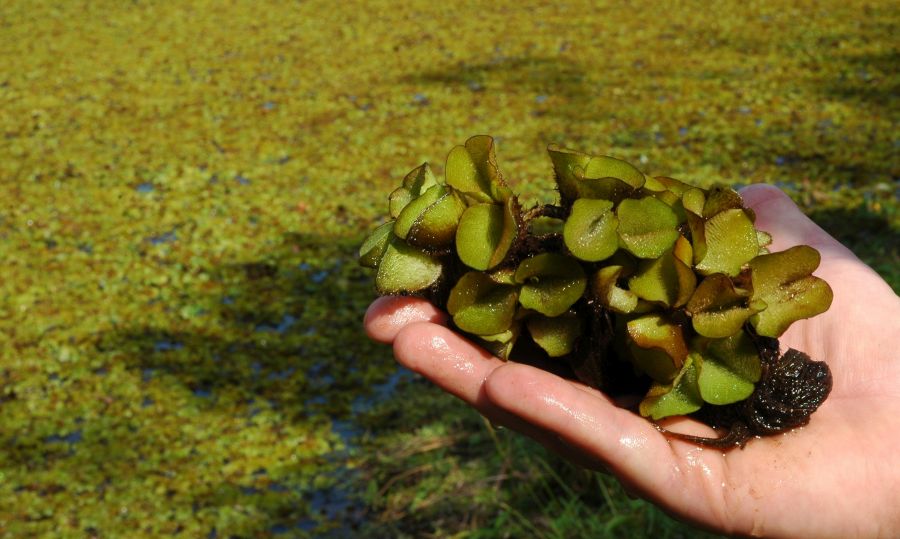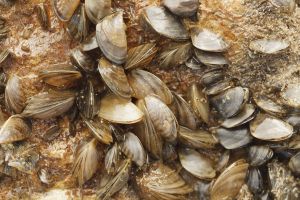Source: Texas Parks and Wildlife Department | April 7, 2021
After five years of enhanced funding for efforts to protect lakes, rivers, water recreationists and industry from a host of non-native invasive species, the Texas Parks and Wildlife Department and its partners are reporting significant achievements. The TPWD is currently managing invasive aquatic plants on more than 50 water bodies around the state to enhance boater access along with actively monitoring for early detection of multiple species and implementing rapid response and eradication efforts where possible.
Thanks to funding allocated for these efforts by the Texas Legislature, over the past five years more than 60,000 acres of giant salvinia, 6,000 acres of water hyacinth, and nearly 1,000 acres of other species of aquatic plants have been treated to promote boater access. Also, nearly 1.5 million giant salvinia weevils were introduced as biological controls. New projects to manage river and creekside invasive plants have also been implemented, offering control of problematic Arundo and saltcedar to more than 425 landowners and making great progress in restoring these habitats.
TPWD manages freshwater fisheries and other aquatic resources, providing recreationally and economically valuable freshwater fishing opportunities across the state. During the past five years, TPWD has invested increased legislative funding and leveraged partnerships to make significant achievements in combating aquatic invasive species that pose a significant threat to these resources.
Aquatic invasive species are a threat not only to these resources through their ability to degrade waterways and negatively impact native aquatic life but also to fishing, boating, and hunting opportunities. In addition, water supply and control infrastructure and boats can be damaged by these organisms and even waterfront property values can be negatively affected.
Nationwide, the annual economic impact of all invasive species in the U.S. has reached approximately $219 billion, with global impacts estimated at over $4 trillion. Aquatic invasive species are among the worst of these, requiring considerable effort to prevent, monitor for, and effectively manage and mitigate infestations when possible. In response to this need, for the past five years — since state fiscal year 2016 — the Texas Legislature has allocated approximately $3.2 million per year to combat aquatic invasive species in Texas.
The TPWD coordinates cooperative aquatic invasive species management efforts with numerous partners to implement public outreach and prevention, early detection, rapid response, and effective long-term management using integrated pest management strategies.
Prevention is widely recognized as the frontline in the fight against aquatic invasive species. To increase awareness of aquatic invasive species and enlist boaters’ help in slowing their spread, TPWD and a coalition of partners mount an outreach campaign each year from Memorial Day through Labor Day urging boaters to ‘Clean, Drain and Dry.’ Billboards, digital and social media advertising, direct outreach to registered boaters, and signage at boat ramps are used to spread the word. In the past five years, this campaign has generated nearly 800 million “impressions,” and 91% of boaters surveyed have heard the ‘Clean, Drain and Dry’ message.
“The campaign reminds boaters that they have the power to protect the lakes we love from invasive species. By taking three simple steps —Clean, Drain and Dry — boaters can stop the spread of invasive species,” said Brian Van Zee, TPWD Inland Fisheries Regional Director. “Before leaving a lake, clean all plants and mud from the boat and drain all water from the boat and onboard receptacles. Then when you get home, open up all the compartments and allow the boat to dry completely before it’s launched again.”
Zebra mussels are one of the most problematic aquatic invasive species in the state. Zebra mussels attach to and damage boats and water supply and control infrastructure, causing significant economic damage. They also impact human health and quality of life, littering shorelines and underwater surfaces with hazardous, razor sharp shells that can cause cuts, and can even affect drinking water quality.
The TPWD and 15 partner entities work together to monitor more than 40 lakes for early detection of invasive mussels and monitor existing zebra mussel populations in more than 20 water bodies. Early detection is essential, not only for providing water infrastructure operators guidance on how to prevent the impacts of the invasive mussels, but also for mounting a rapid response such as the recent, unprecedented eradication of zebra mussels from Lake Waco. First detected in a highly localized area of the lake in 2014, zebra mussels were successfully eradicated through a rapid response involving placement of plastic sheeting on an area of the shoreline and lake bottom, followed by five years of careful monitoring for mussels.
“Once zebra mussels are established in a lake or have dispersed beyond the introduction site, there is simply no way to eradicate or even manage this highly invasive species other than efforts to mitigate their impacts on water infrastructure,” said Monica McGarrity, TPWD senior scientist for aquatic invasive species. “In the case of Lake Waco, the eradication would not have been possible without the advantage of detecting the mussels early while they were still extremely localized.”
Aquatic invasive plants such as giant salvinia are also extremely problematic in Texas, growing very rapidly and forming dense mats that impede lake access for fishing, boating, hunting, and other activities. Large infestations of aquatic invasive plants can even reduce waterfront property values and impede water supply and flow.
“Our integrated pest management strategy for invasive aquatic plant management continues to improve, as we employ mechanical booms to contain plants for rapid response and to prevent spread, explore new herbicide treatment options, and continue the use of biological controls,” said John Findeisen, TPWD Aquatic Habitat Enhancement Team lead. “Through a combination of floating booms and several herbicides, giant salvinia was successfully eradicated from Lake Fork in 2019. However, common salvinia—another invasive aquatic plant — can still be found in the reservoir.”
Texas rivers and streams are also plagued with invasive plants that grow along their banks, such as arundo (a.k.a. giant reed or Carrizo cane) and saltcedar. These invasive riparian plants dominate the banks, crowding out native plants, impeding access, altering the very shape of the river and degrading instream habitats for aquatic life. Since late 2015, intensive partnership efforts have been underway across six different watersheds to manage these species to restore habitat for native fish and wildlife species.
Texas has also supported research on aquatic invasive species ranging from zebra mussels to aquatic plants to fishes that aids in evaluating their impacts and developing more effective prevention and management strategies. Science plays a key role in supporting statewide monitoring and management efforts.
Aquatic invasive species are a critical problem that isn’t going away and must continue to be addressed long term. For Texas to keep pace with the constant and ever-evolving problems associated with aquatic invasive species, it is critically important that we continue to invest in targeted control, prevention, monitoring, and research efforts.
To learn more about TPWD’s efforts to combat aquatic invasive species and read the full five-year report, visit http://bit.ly/aquatic-invasives. For more information about invasive species in Texas, visit Texasinvasives.org.


